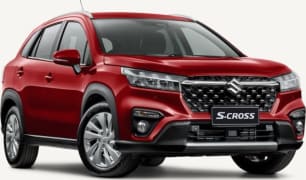Besides the inherent reliability of buying Suzuki, one of the previous S-Cross’s biggest advantages was its spacious and practical interior.
Of course, dimensionally almost everything carries over, so it remains easy to get in thanks to big doors that open wide. There’s ample space front and rear, with sufficient headroom, legroom and shoulder width for an SUV in this class front and back, while good all-round vision is afforded by a commanding driving position and plenty of glass.
Objectively, the S-Cross’ cabin is difficult to fault.
The front seats are broad but seem supportive enough. Most people should find the right driving position ahead of the (carryover) steering wheel, that adjusts for reach as well as height.
The instrument dials are clear and simple to decipher, aided by the addition of an auxiliary digital speedo (at last). There’s no missing the camera within the newly-elevated centre touchscreen. It’s an easy stretch to the climate control buttons and there are several places to store things in or on, especially in the large-ish glove box.
Front and rear centre armrests are also fitted, with the rears containing cupholders. Additionally, while there is lots of hardwearing plastic, it seems of decent quality and is well glued together.
Nobody will be intimidated by the unfamiliar in this Suzuki. Timid and perhaps even older drivers in particular ought to feel at home.
However, repositioned centre console and updated multimedia screen apart, it’s much the same as when the first S-Cross surfaced in 2013, and that might be an issue for potential buyers seeking to buy a $45,000 to $50,000 SUV.
More annoyingly, the front passenger seat lacks a cushion height adjuster; there is no physical volume knob for the multimedia system, so users must tap or jab a screen or disturb the driver by using the steering wheel switch instead; the rear seat has no passenger-facing air vents; and the 7.0-inch touchscreen is laughably tiny in 2022.
Plus, the Prestige’s missing equipment as found in some similarly-priced up-spec rivals might put people off; no head-up display, heated seats, wireless charger or configurable instrumentation are just a few of them. It all feels old and not premium enough – something a quick visit to a Kia, Hyundai or Nissan dealer will immediately reveal.
Never mind. At least the rear backrest reclines (a tiny bit) for added comfort, while further back, boot capacity remains the same at 430 litres. The backrest has a 60:40 split and the floor can be positioned in different locations. With the seats folded down, capacity rises to 665L, while maximum volume is 1230L. The load area is flat and wide and a space saver spare wheel is located beneath the boot floor.
Overall, then, the S-Cross is a pleasant and accommodating package, but one that will seem dated compared to newer rivals.

















































 copy.png)




.png)







